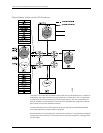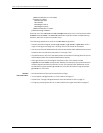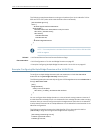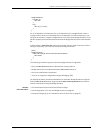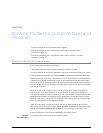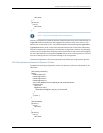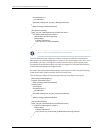
CHAPTER 6
Dynamic Profiles for VLAN Interfaces and
Protocols
•
Dynamic Profiles for VPLS Pseudowires on page 63
•
Example: Configuring VPLS Pseudowires with Dynamic Profiles—Basic
Solutions on page 64
•
Example: Configuring VPLS Pseudowires with Dynamic Profiles—Complex
Solutions on page 68
Dynamic Profiles for VPLS Pseudowires
A router often has two types of interfaces:
•
Static interfaces, which are configured before the router is booted
•
Dynamic interfaces, which are created after the router is booted and while it is running
A VPLSpseudowireinterface(such aslsi.1048576) is dynamically created by thesystem.
Therefore, the logical interface unit number for the VPLS pseudowire is not available for
in advance to configure characteristics such as VLAN identifiers and other parameters.
As aresult, certainVLAN manipulation featuresthatare easilyapplied tostaticinterfaces
(such as xe-, ge-, andso on) areeither notsupported on dynamicinterfacesor supported
in an awkward fashion.
However, on MX Series routers, there is another configuration method that dynamic
interfaces can use to determine their VLAN parameters when they are created by a
running router: dynamicprofiles.A dynamic profile isa conceptualcontainerthatincludes
parameters associated with a dynamic entity, parameters whose values are not know
at the time the entity is configured. For more information about dynamic profiles, see the
Junos OS Subscriber Access Configuration Guide.
There are many types of dynamic profiles. The two dynamic profiles that are used in
conjunction with VLANs and VPLS are $junos-interface-ifd-name for a dynamic physical
interface and $junos-underlying-unit-number for a dynamic logical interface (unit).
Dynamic profiles for VPLS are only supported on MX Series routers.
Related
Documentation
MX Series Ethernet Services Routers Solutions Page•
63Copyright © 2010, Juniper Networks, Inc.




